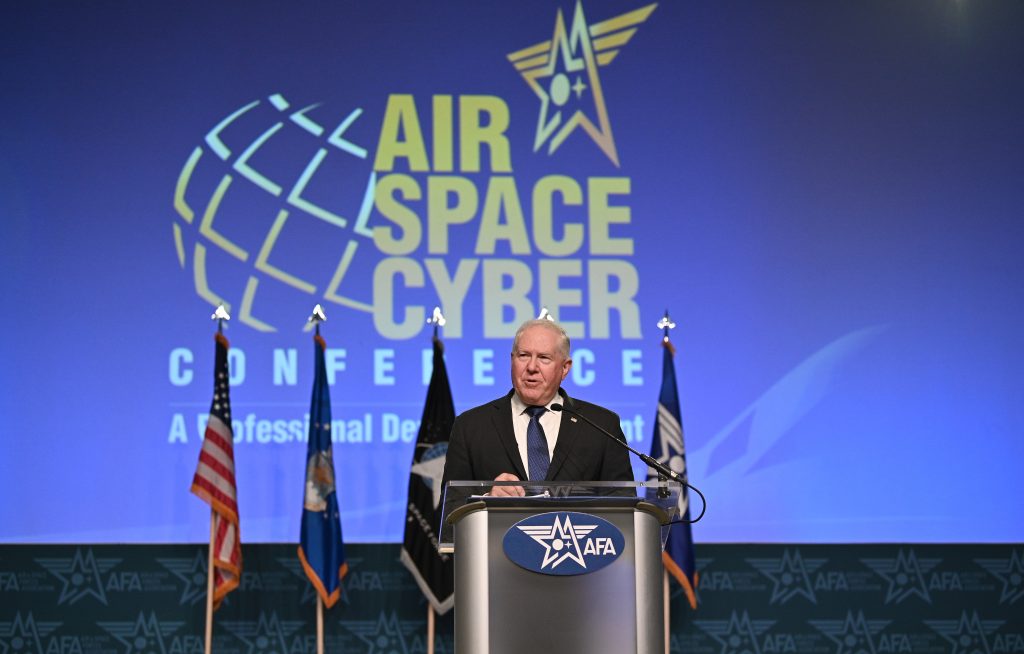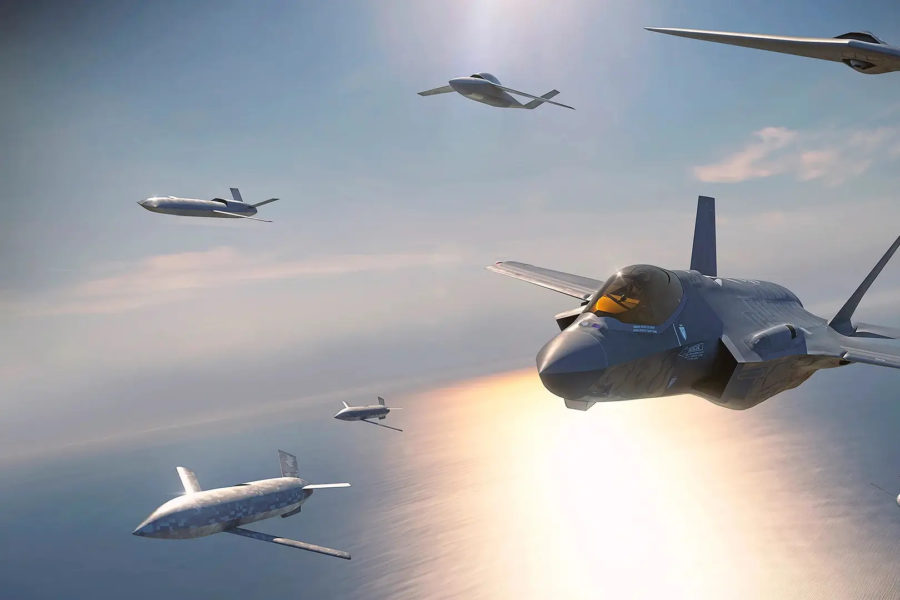The House of Representatives has proposed cost limits on Collaborative Combat Aircraft as part of its 2024 defense policy bill—but Air Force Secretary Frank Kendall expressed puzzlement at the numbers Sept. 11 and indicated the service is not pursuing the kinds of systems Congress is talking about.
“We’re very opposed to those targets,” Kendall told reporters at AFA’s Air, Space & Cyber conference in National Harbor, Md. “I don’t know where those categories come from, but they’re not what we’re doing.”
In its version of the 2024 National Defense Authorization Act, the House approved a provision setting cost limits of:
- $3 million each for an “expendable” CCA, defined as an aircraft designed not to be used more than once
- $10 million for an “attritable” CCA, defined as an aircraft intended to be used more than once but whose occasional loss in combat would be deemed acceptable
- $25 million for an “exquisite” model, defined as one meant to be reused and whose loss would be deemed not acceptable.
The Senate did not include such a provision in its version of the NDAA, and the idea has not been hashed out in conference yet.
Instead of the three classifications offered by the House, Kendall indicated that “we’ve got two increments planned” but did not elaborate on what they were. He has not set any cost boundaries for CCAs beyond the goal of buying them at “a fraction of [the cost of] an F-35,” which in the last contract with Lockheed Martin was about $80 million per aircraft.
Competition
Kendall said the Air Force plans “an open competition” for CCAs—unmanned, autonomous aircraft that will pair with manned platforms—that will be affected by an ongoing effectiveness analysis and “maturity of the technology.”
An Air Force official said the service doesn’t want to limit the program, which is “in its early stages.”
“What we’re trying to get industry to do is to mature technology and be creative, and then demonstrate to us what kind of capabilities they can provide, and [show] why it’s cost-effective. And that’s how we’re going to be selecting which ones we carry to the next phase of competition,” Kendall explained.
Kendall said the Air Force has not yet settled on an acquisition strategy for CCAs, other than to note that the service has budgeted some $5.8 billion across the the next five years to pursue the effort, which he has described as producing more than 2,000 airframes.
“We’re pretty wide open in terms of possibilities right now,” he said. “We do want to maintain competition as long as we possibly can. I think there’s a lot of value in that.”
Andrew Hunter, the Air Force’s acquisition executive, did tell reporters that “continuous competition is the core of our acquisition approach for CCA.”
He also said CCAs will “leverage … the Advanced Mission Systems government reference architecture developed through the [Next Generation Air Dominance] program.” That architecture “gives us a lot of a lot of opportunity to kind of mix and match” capabilities on a single CCA airframe, which is “the idea of a modular open systems architecture approach.”
Hunter said being able to “integrate capabilities rapidly from a wide variety of sources and then upgrade them, [and] iterate them over time” is another key part of the CCA acquisition approach.

B-21 Back on the Table
Kendall’s original take on his “seven operational imperatives” included building CCA-like aircraft to accompany the B-21 bomber on long-range strike missions. He later withdrew the idea, though, saying it had proved “cost ineffective” in analysis.
However, he left the door open to the idea of CCAs operating jointly with B-21s.
“When we started the operational imperatives, we thought initially that we might find a good cost effectiveness case for dedicated, uncrewed combat aircraft that would accompany the B-21. That didn’t turn out to be the case, as we got into the analysis,” he said, but there may be a viable concept in which “basically, the B-21 picks up CCAs as it gets closer to the operating area.”
CCAs offer “a lot of really interesting tactical possibilities,” Kendall added, and while the planned family of systems that will support the B-21 is classified, Kendall said it includes “things that could be carried by, or possibly accompany, the B-21,” such as munitions and “other things that can be used for defensive purposes, for example.”
Asked to name a mission that might be well suited for a CCA supporting the B-21, Kendall ventured, “defensive capability” for the bomber or providing it with “better situational awareness,” but he cautioned he was speculating.
Much is still uncertain regarding CCAs—Kendall said the service still has not yet settled on how many drones would accompany a crewed aircraft
He has previously speculated that each F-35, for example, could be partnered with up to five CCAs, but “that’s still unknown,” he said.
“We would like to have at least two,” he added. “More is better; you get more cost effectiveness if you can do more, but you’ve got to have technology that can allow the crewed aircraft to control that number, and do it effectively.
Excitement in Congress
Air Force officials have reported that lawmakers and staff on Capitol Hill are extremely enthused about CCAs as offering a grand solution to the Air Force’s capacity, cost, and mass problems.
“I’m grateful for the support,” Kendall said. “I’m glad that people are excited. … I’m excited about it. I think it’s a good concept. It’s very cost-effective. And the reaction we’ve gotten from industry and others who’ve looked at it is very positive.”
But there is still much work left to be done, he warned, and the Air Force is still “doing efforts to experiment with operational units to try to get a sense of how our CCAs would fit into an operational unit,” he noted, “and we’re doing some things to mature the technology; particularly for autonomy.”
As far as being the Air Force’s silver bullet problem solver, Kendall said the CCA concept “doesn’t get us out of the woods entirely on long-term affordability, for example, but it’s going to be a much more cost effective” approach than attempting to build mass with crewed aircraft.
The “Replicator” program outlined recently by Deputy Defense Secretary Kathleen Hicks, which would build large numbers of “attritable” air, land, sea and space vehicles, is “a completely separate thing” from CCAs, Kendall said. He has previously described CCAs as modular and re-usable vehicles that will be integrated with crewed fighter squadrons, and perform functions like those now carried out by pods on fighters: target designation, electronic warfare, sensing, and as carriers of additional munitions.
“We have some candidates in the Air Force” for Replicators, Kendall said, and when he presented those ideas to Hicks, “some of those she looks on very positively, but we haven’t resolved all that yet,” Kendall said.
But the Air Force is all in on CCAs, Kendall said.
“The more we learn about the idea of the CCA and how it can fit into our operational context, the more interesting and appealing it becomes. That’s one of the reasons [for] … the excitement about it. There’s reason to be excited about it. It offers a lot of really interesting tactical possibilities,” Kendall said.
